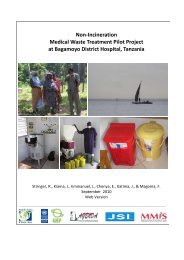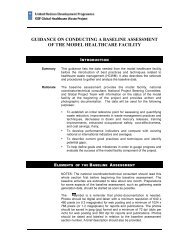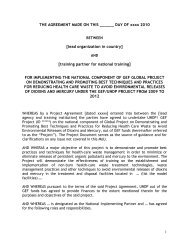Latvia
Latvia
Latvia
Create successful ePaper yourself
Turn your PDF publications into a flip-book with our unique Google optimized e-Paper software.
Health systems in transition<br />
<strong>Latvia</strong><br />
Table 5.2 Inpatient utilization, 2000–2005<br />
Inpatient care admissions per 100 ALOS, all hospitals<br />
2000 22.2 11.4<br />
2001 21.1 11.3<br />
2002 20.4 11.0<br />
2003 20.9 10.8<br />
2004 21.1 10.6<br />
2005 22.1 10.0<br />
Source: WHO Regional Office for Europe 2007a.<br />
Note: ALOS: Average length of stay.<br />
Capital stock and investments<br />
By the end of 2005 there were 109 inpatient institutions in <strong>Latvia</strong>, compared to<br />
119 at the end of 2004. Hospitals are located in all the largest cities and districts.<br />
The size of the hospitals varies, with 45 hospitals having up to 49 beds, 14<br />
hospitals with 55–99 beds, 23 hospitals having 100–199 beds, 14 hospitals with<br />
200–399 beds, 8 hospitals with 400–699 beds, and 5 hospitals having over 700<br />
beds. In comparison with previous years, the number of the smaller hospitals<br />
(with fewer than 99 beds) has decreased notably.<br />
The ownership form of the hospitals also varies. In 2004 in <strong>Latvia</strong> there were<br />
40 state hospitals, 62 local-level hospitals and 17 private hospitals.<br />
In the period up to the Second World War, 19 hospitals had been built, which<br />
are still in operation today. In the period 1945–1980, 55 hospitals were built<br />
or reconstructed, while after 1980 and up to the end of 2005 an additional 35<br />
hospitals were newly constructed or rebuilt. The hospitals that were built before<br />
the war are mostly pavilion-type hospitals, while those built in the period after<br />
the war are block houses connected with big corridors, in accordance with the<br />
health care-related architectural style known as Minimalist Megahospitals.<br />
In this type of hospital, less attention is paid to strategic aspects, such as<br />
performance of medical procedures, their mutual relations, etc.<br />
Research on the condition of the buildings of health institutions was first<br />
carried out in 1986, but the data accumulated then are not currently useable<br />
as they do not reflect the real situation. Since then, several studies have been<br />
carried out, for example a telephone survey conducted by the HSMTSA<br />
investigating the degree to which hospitals are equipped with generators<br />
supplying electrical power in the event of power cuts. Following a request by<br />
the Ministry of Defence, data were collected concerning the hospitals’ provision<br />
with helicopter landing spots, possibilities to reach hospitals by use of railway<br />
and water routes, the existence of nearby or on-site pharmacies, the possibilities<br />
of treatment and laboratory diagnostics and the amount of services available.<br />
133
















